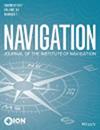Spatiotemporal Deep Learning Network for High-Latitude Ionospheric Phase Scintillation Forecasting
IF 2
3区 地球科学
Q1 ENGINEERING, AEROSPACE
引用次数: 1
Abstract
In this paper, we present a spatiotemporal deep learning (STDL) network to conduct binary phase scintillation forecasting at a high-latitude global navigation satellite systems (GNSS) station. Historical measurements from the target and surrounding GNSS stations are utilized. In addition, external features such as solar wind parameters and geomagnetic activity indices are also included. The results show that the STDL network can adaptively incorporate spatiotemporal and external information to achieve the best performance by outperforming a naive method, three conventional machine learning algorithms (logistic regression, gradient boosting decision tree, and fully connected neural network) and a machine learning algorithm known as long short-term memory that incorporates temporal information.高纬度电离层相位闪烁预测的时空深度学习网络
本文提出了一种基于时空深度学习(STDL)网络的高纬度全球导航卫星系统(GNSS)站二相闪烁预测方法。利用了目标和周围GNSS站的历史测量值。此外,还包括太阳风参数和地磁活动指数等外部特征。结果表明,STDL网络可以自适应地整合时空和外部信息,优于朴素方法、三种传统机器学习算法(逻辑回归、梯度增强决策树和全连接神经网络)和一种整合时间信息的长短期记忆机器学习算法,从而达到最佳性能。
本文章由计算机程序翻译,如有差异,请以英文原文为准。
求助全文
约1分钟内获得全文
求助全文
来源期刊

Navigation-Journal of the Institute of Navigation
ENGINEERING, AEROSPACE-REMOTE SENSING
CiteScore
5.60
自引率
13.60%
发文量
31
期刊介绍:
NAVIGATION is a quarterly journal published by The Institute of Navigation. The journal publishes original, peer-reviewed articles on all areas related to the science, engineering and art of Positioning, Navigation and Timing (PNT) covering land (including indoor use), sea, air and space applications. PNT technologies of interest encompass navigation satellite systems (both global and regional), inertial navigation, electro-optical systems including LiDAR and imaging sensors, and radio-frequency ranging and timing systems, including those using signals of opportunity from communication systems and other non-traditional PNT sources. Articles about PNT algorithms and methods, such as for error characterization and mitigation, integrity analysis, PNT signal processing and multi-sensor integration, are welcome. The journal also accepts articles on non-traditional applications of PNT systems, including remote sensing of the Earth’s surface or atmosphere, as well as selected historical and survey articles.
 求助内容:
求助内容: 应助结果提醒方式:
应助结果提醒方式:


